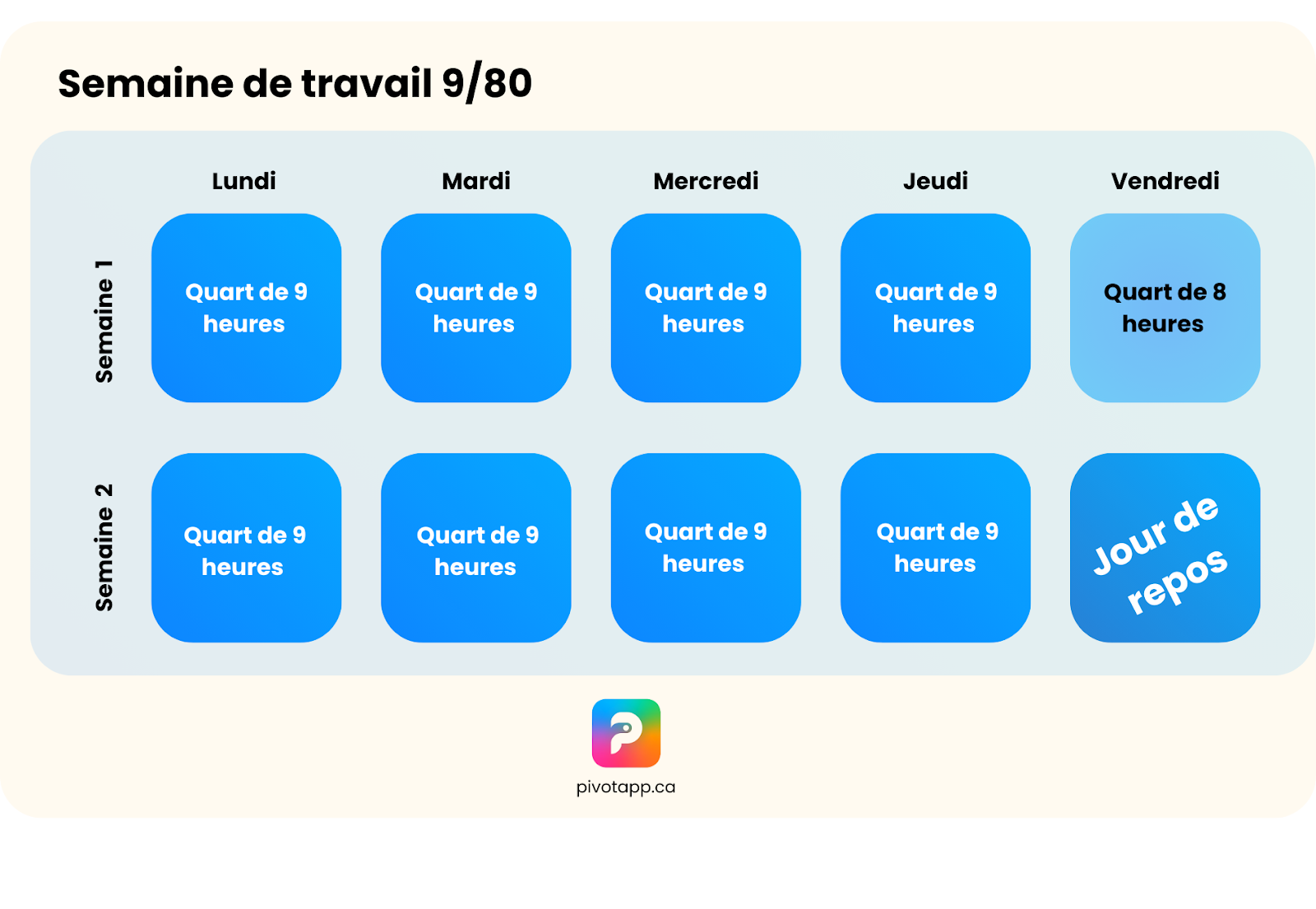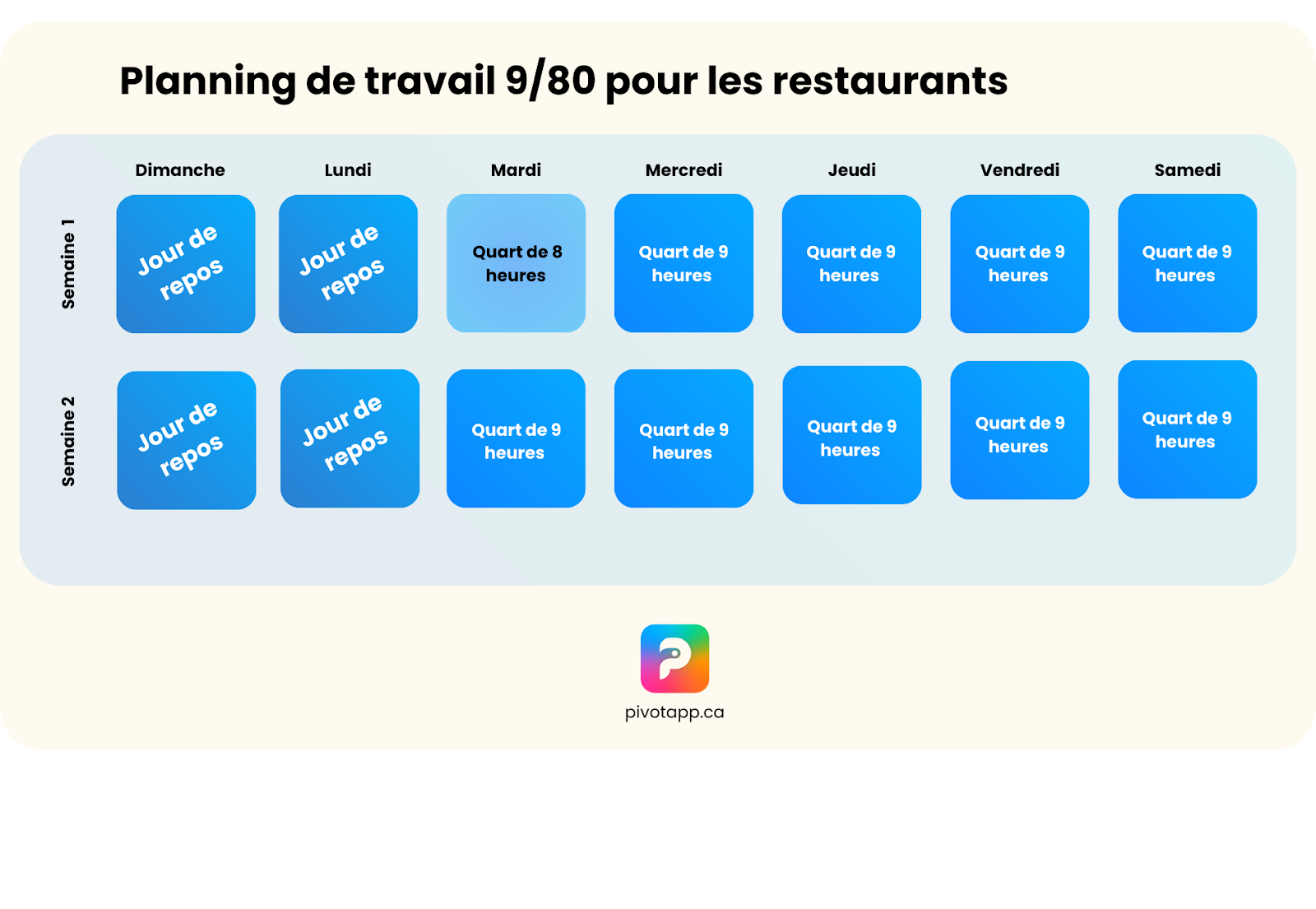A 9/80 schedule planning is a two-week work organization where employees work longer days to get a day off every two weeks. Instead of the usual 8-hour days, they work 9 hours a day for eight days, then 8 hours on a Friday, for a total of 80 hours over two weeks. The following Friday is a full day of rest, offering a long weekend twice a month.
9/80 schedule planning example:
Week 1
Monday to Thursday: 9:00am — 6:00pm (9 am including lunch break)
Friday: 9:00am — 5:00pm (8 am)
Week 2
Monday to Thursday: 9:00am — 6:00pm (9 am)
Friday: rest
This system makes it possible to maintain full time while offering employees more time to rest or recharge their batteries.

Benefits of 9/80 schedule planning in catering
While traditional 9/80 schedule planning doesn't fit all restaurants, a modified version that focuses on busy and low-traffic days can offer real benefits for employers and restaurant employees.
✅ Improves productivity and morale
Allowing employees to work longer hours during busy days (like Thursday to Saturday) in exchange for a weekday off helps maintain their energy. A break during quieter days helps recharge the batteries, which can reduce last-minute absences and improve customer service.
✅ Offers smart flexibility
Restaurants may stagger vacation days to maintain coverage. For example, one group takes time off on Monday, the other on Tuesday. Everyone enjoys a predictable rest without compromising the quality of service.
✅ Promotes a better balance between professional and personal life
Offering a fixed day off during the week helps with medical appointments, procedures, or rest. And because it's integrated into schedule planning, it limits last-minute requests.
✅ Increases room staff income
Even though strict 9/80 schedule planning is difficult to apply in catering, an adapted version can work well for waiters, bartenders, and hosts.
For example, they may work an extra hour during busy evenings (Thursday to Saturday) and take a quiet day (Monday or Tuesday) as a break.
Two possible benefits:
- Better tipping opportunities
More customers + more table rotations = more tips, therefore a higher effective hourly income. - Real time to rest
A quiet weekday off allows you to take a break without losing the best moments of income.
Adapt 9/80 schedule planning to catering staff
More flexibility, but not a one-size-fits-all solution
As restaurants work differently than offices (open weekends and evenings), 9/80 schedule planning should be customized by role or employee. For example:
Example of schedule planning adapted to a restaurant:
Week 1
Sun: Rest
Moon: Rest
Tue: 8 am
Wed — Sat: 9 hours/day
Week 2
Sun: Rest
Mon: Extra rest day
Tue — Sat: 9 hours/day

This model always offers an additional day of rest every two weeks while optimizing schedules during busy days.
📌 Each restaurant is different: adapt according to the roles, opening hours and availability of the team. And always check local laws about overtime, breaks, and payroll.
Disadvantages of 9/80 schedule planning
While this planning has clear benefits, it also has concrete limitations:
⚠️ Longer days
For some, 9-hour days are exhausting, especially with a long commute to and from work.
“It's nice to have a free Friday, but long days are hard, especially after an hour of travel.” — Reddit user
⚠️ Less work/personal life balance than it seems
Long days can eat up all the time available. The day becomes:
Alarm → Commute → 9 hours of work → Return → Eat → Sleep
Little or no time for family, errands, or rest.
⚠️ More complex payroll rules
Precise time tracking is becoming crucial. The FLSA (Fair Labor Standards Act) imposes rigor in tracking time and defining the start of the work week, at the risk of violating overtime rules.
⚠️ Incompatible with certain catering realities
- Difficult to extend the shift to 9 am in physically demanding positions (waiter, cook, host).
- Impossible to “close on Fridays” in a restaurant.
- If an employee takes his Friday 9/80, others have to compensate.
How to set up a 9/80 schedule schedule with Pivot
With Pivot, you can structure a 9/80 schedule in a smooth way:
1. Talk to your team
Explain the benefits of scheduling. Gather their preferences for rest days. Pivot makes it easy to incorporate their availability into planning.
2. Collect availability
With Pivot, employees submit their available slots and time off requests via the app.
3. Create a schedule adapted to everyone
Plan longer shifts on busy days (Thursday to Saturday) and allow for a day off during the quiet week. Pivot helps you balance load, breaks, and costs.
4. Publish and share
Once the schedule schedule is ready, publish it to Pivot. The whole team sees it in real time on their phone.
5. Define rules for shift exchanges
Pivot allows you to control exchanges to avoid excessive hours or working on a day off.
6. Anticipate public holidays and exceptions
Use Pivot to adjust schedules in advance in case of closures or short weeks.
7. Analyze, adjust, improve
Track the impact of planning: turnover, fatigue, morale. Pivot gives you the data to adjust as needed.
Best practices for successfully implementing a 9/80
- Make it voluntary
Don't impose it. Offer it as an option or test it with a pilot group. - Use the right tools
You need tools that can:
- Track the hours over two weeks
- Trigger overtime alerts
- Follow the 80-hour thresholds
- Track the hours over two weeks
- Plan for a flexible integration of leave
Allow employees to:
- Accumulate recovery time
- Move their day off if something unexpected happens
- Ask for an alternative day if needed
- Accumulate recovery time
- Communicate clearly
Explain how it works, who is eligible, and what rules apply.
Use Pivot to centralize announcements and keep the whole team aligned.

.avif)

.png)


